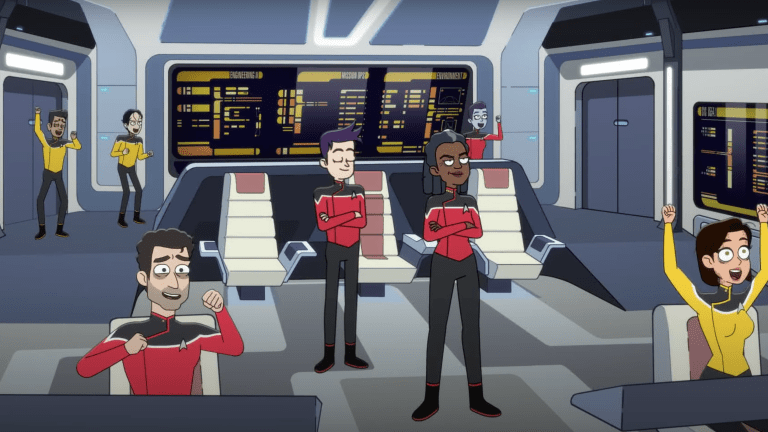Star Trek: Lower Decks Timeline Explained
Confused about the timeline of Lower Decks? Don’t be. It’s probably the coziest moment in all of Trek canon... or is it?

This article contains minor spoilers for Star Trek: Lower Decks.
Just in case you’re confused, the new animated comedy series, Star Trek: Lower Decks, is not a spoof. Although there are some meta-fictional elements (just how the hell did Mariner have dreams about Khan?) the series isn’t a comedy-spoof of Star Trek, but rather, a comedy series that is set within the Trek canon. As creator and showrunner Mike McMahan has said many times, Lower Decks is canon, meaning things that happen on this series, could, in theory, affect other shows.
But, in terms of the Lower Decks timeline, what does that really mean? How does it fit into the large story of Star Trek, and does it really matter? Here’s how it works, and why the placement of Lower Decks in the Trek timeline might be a bigger deal than we thought.
So, here’s the easy answer to the Lower Decks chronology question: The series takes place in 2380, which is one year after Nemesis and two years after Voyager returned to Earth. It’s also five years prior to the earliest flashbacks in Star Trek: Picard, meaning the Synth Revolt on Mars and the Romulan Supernova of 2387 is all in the relatively near future. Lower Decks also takes place five years after the end of the Dominion War, which could indicate that Starfleet and the Federation are experiencing a period of rebirth and renewal. In other words, Lower Decks is sandwiched in a “stable” period in the Trek timeline. There are no major wars, and the majority of the superpowers in the Alpha and Beta Quadrants are behaving the way you remember in TNG or DS9, only, if anything, even calmer.
That said, because everything is about to change in five years, Lower Decks could subtly gesture at what’s coming.
Synth Labor
By 2285, synthetical android labor was common enough in the Federation, that several Synth units were used at the Utopia Plantia Shipyards on Mars to help construct new ships for Picard’s “Rescue Armada” of the Romulans. That said, the existence of Synth Labor wasn’t something we’d seen in Trek canon up until these flashbacks, meaning, it had to start somewhere. Because Lower Decks is set only five years prior to the big Mars revolt, it feels reasonable that we could see some of these Synths onboard the USS Cerritos.
Holographic Rights
So far, in the first two episodes of Lower Decks, we have not the USS Cerritos version of an Emergency Medical Hologram, or any other kind of sentient holograms. In Voyager, the Doctor was able to start a movement for holograms to be recognized as sentient lifeforms, much in the same way Data was protected in TNG as an android. But did it happen? We know that in 2399 — during the time of Picard — that all sorts of emergency holograms exist on starships. But, it should be noted that the various holograms used by Captain Rios on the La Sirena, are all non-Starfleet. The La Sirena is a commercial vessel, and it stands to reason its pre-programmed hologram package is commercial, too. So, the question remains, did Starfleet stop using sentient holograms after 2378, or what?
Want to stream more Star Trek? Try a free trial of CBS All Access, on us!
What’s up with the Borg?
The ending of the series finale of SmorgasBorg could have led many of us to believe that Captain Janeway had entirely defeated the Borg Collective for the last time in 2378. But, in 2380, in the second episode of Lower Decks, we know the Borg are still feared enough that at least one Holodeck simulation (called “SmorgasBorg”) exists to teach Starfleet officers about failure. And, the backstory of Star Trek: Picard tells us that the “Artifact,” a Borg Cube that was severed from the Collective sometime in the 2380s while in Romulan Space. The fact that a Borg Cube was operating in Romulans Space (the Beta Quandrant) might be relevant for Lower Decks, and future Trek canon going forward. By 2399, in Picard, you 100 percent get the sense that the Collective is still very much a threat, but that the Artifact just happened to be disconnected from it. Did the Borg give up on the Alpha Quadrant? Are the focused in the Beta Quadrant during the time of Lower Decks? A future episode — hypothetically — could tell us.
Humanoid Augmentation
Of all the sly canon changes Lower Decks has slipped in, the one that seems the most subtle is the way in which everyone on the ship accepts the fact that Rutherford recently has had cybernetic augmentation. Other than Airiam in Star Trek: Discovery, willing cyborgs in Trek are fairly rare, and almost unheard of in Starfleet. If anything, Rutherford’s augmentation seems to be a close cousin of the kind of genetic or artificial enhancement that the Federation generally frowned-upon. Seemingly, Airiam was an exception because her life was saved by her Cybernetic augmentation, but what about Rutherford? Is this kind of cybernetic enhancement common in the Federation, and we’ve just not seen much of it? Or did some cyber laws actually change?
Even if Lower Decks doesn’t outright address Rutherford’s enchantment, or any of these other fun canon questions, you can bet that at some point, in the future, some version of Star Trek, totally will.
Star Trek: Lower Decks airs new episodes on Thursdays on CBS All Access.
